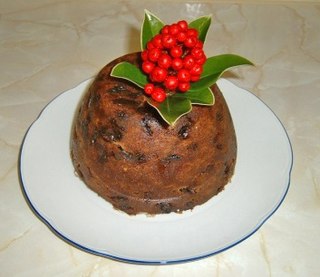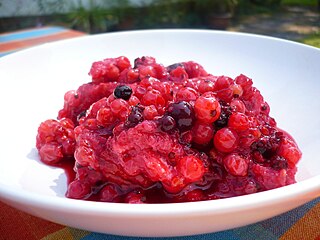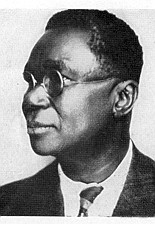
Haggis is a savoury pudding containing sheep's pluck, minced with chopped onion, oatmeal, suet, spices, and salt, mixed with stock, and cooked while traditionally encased in the animal's stomach though now an artificial casing is often used instead. According to the 2001 English edition of the Larousse Gastronomique: "Although its description is not immediately appealing, haggis has an excellent nutty texture and delicious savoury flavour".

Yorkshire pudding is a baked pudding made from a batter of eggs, flour, and milk or water. A common English side dish, it is a versatile food that can be served in numerous ways depending on its ingredients, size, and the accompanying components of the meal. As a first course, it can be served with onion gravy. For a main course, it may be served with meat and gravy — traditionally roast beef — as part of the traditional Sunday roast, but can also be filled with foods such as bangers and mash to make a meal. Sausages can be added to make toad in the hole. In some parts of England, the Yorkshire pudding can be eaten as a dessert, with a sweet sauce called raspberry vinegar. The 18th-century cookery writer Hannah Glasse was the first to use the term "Yorkshire pudding" in print.

Custard is a variety of culinary preparations based on sweetened milk, cheese, or cream cooked with egg or egg yolk to thicken it, and sometimes also flour, corn starch, or gelatin. Depending on the recipe, custard may vary in consistency from a thin pouring sauce to the thick pastry cream used to fill éclairs. The most common custards are used in custard desserts or dessert sauces and typically include sugar and vanilla; however, savory custards are also found, e.g., in quiche.

Head cheese or brawn is a cold cut terrine or meat jelly that originated in Europe, perhaps ancient Germania. It is made with flesh from the head of a calf or pig, typically set in aspic, and usually eaten cold, at room temperature, or in a sandwich. Despite its name, the dish is not a cheese and contains no dairy products. The parts of the head used vary, and may include the tongue but do not commonly include the brain, eyes or ears. Trimmings from more commonly eaten cuts of pork and veal are often used, and sometimes the feet and heart, with gelatin added as a binder.

Gnocchi are a varied family of dumplings in Italian cuisine. They are made of small lumps of dough, such as those composed of a simple combination of wheat flour, potato, egg, and salt. Variations of the dish supplement the simple recipe with flavour additives, such as semolina flour, cheese, breadcrumbs, cornmeal or similar ingredients, and possibly including herbs, vegetables, and other ingredients. Base ingredients may be substituted with alternatives such as sweet potatoes for potatoes or rice flour for wheat flour. Such variations are often considered to be non-traditional.

Mytholmroyd is a large village and former civil parish, now in the parish of Hebden Royd, in the Calderdale district, in West Yorkshire, England, 2 miles (3 km) east of Hebden Bridge. It lies in the Upper Calder Valley, 10 miles (16 km) east of Burnley and 7 miles (11 km) west of Halifax. The village, which has a population of approximately 4,000, is in the Luddendenfoot Ward of Calderdale Council.

Pudding is a type of food. It can be either a dessert, served after the main meal, or a savoury dish, served as part of the main meal.

Christmas pudding is sweet, dried-fruit pudding traditionally served as part of Christmas dinner in Britain and other countries to which the tradition has been exported. It has its origins in medieval England, with early recipes making use of dried fruit, suet, breadcrumbs, flour, eggs and spice, along with liquid such as milk or fortified wine. Later, recipes became more elaborate. In 1845, cookery writer Eliza Acton wrote the first recipe for a dish called "Christmas pudding".

White pudding, oatmeal pudding or mealy pudding is a meat dish popular in the British Isles.
Thorp is a Middle English word for a hamlet or small village.

Kibbeh is a popular dish in the Levant based on spiced lean ground meat and bulgur wheat. Kibbeh is considered to be a national dish of Lebanon and Syria.

Summer pudding or summer fruit pudding is an English dessert made of sliced white bread, layered in a deep bowl with fruit and fruit juice. It is left to soak overnight and turned out onto a plate. The dessert was most popular from the late 19th to the early 20th century. It first appears in print with its current name in 1904, but identical recipes for 'hydropathic pudding' and 'Malvern pudding' from as far back as 1868 have been found.

A fishcake is a culinary dish consisting of filleted fish or other seafood minced or ground, mixed with a starchy ingredient, and fried until golden.

A Dutch baby pancake, sometimes called a German pancake, a Bismarck, a Dutch puff, Hooligan, or a Hootenanny, is a dish that is similar to a large Yorkshire pudding.

İmam bayıldı is a dish in Ottoman cuisine consisting of whole aubergine stuffed with onion, garlic and tomatoes, and simmered in olive oil. It is a zeytinyağlı dish and is found in most of the former Ottoman regions. The dish is served at room temperature or warm.

The Dicranidae are a widespread and diverse subclass of mosses in class Bryopsida, with many species of dry or disturbed areas. They are distinguished by their spores; the peristome teeth are haplolepideous with a 4:2:3 formula, and an exostome is absent.

Mekitsa is a traditional Bulgarian dish made of kneaded dough made with yogurt that is deep fried. They are made with flour, eggs, yogurt, a leavening agent, water, salt, and oil. In Serbia they are called mekike, while in Macedonian mekica or pituljica, and in Bulgaria mekitsa. They are similar to Hungarian lángos and British Yorkshire pudding. Mekitsa is conventionally a breakfast dish.

Mathurin Anghiley was a Gabonese politician who was elected to the French Senate in 1947. His daughter was the trade unionist Simone Saint-Dénis.

Black pudding is a distinct national type of blood sausage originating in the United Kingdom and Ireland. It is made from pork or occasionally beef blood, with pork fat or beef suet, and a cereal, usually oatmeal, oat groats, or barley groats. The high proportion of cereal, along with the use of certain herbs such as pennyroyal, serves to distinguish black pudding from blood sausages eaten in other parts of the world.
Andrew Cunningham Scott is a British geologist, and professor emeritus at Royal Holloway University of London. He won the 2007 Gilbert H. Cady Award from the Geological Society of America for outstanding contributions to coal geology. He is widely regarded an expert on wildfire and charcoal and has highlighted the role of fire in deep time. He also contributes as a palaeobotanist and science communicator.


















